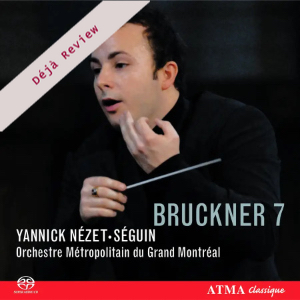
Déjà Review: this review was first published in December 2007 and the recording is still available.
Anton Bruckner (1824-1896)
Symphony No. 7 in E major (1883) [70:03]
Orchestre Metropolitain du Grand Montréal/Yannick Nézet-Séguin
rec. 2006, Église Saint-Nom-de-Jésus, Montréal
Atma Classique SACD22512 [70]
The Leipzig premiere, of the Symphony No. 7, conducted by Artur Nikisch, was perhaps Bruckner’s greatest triumph. It was soon followed by other performances, among which the composer particularly admired the interpretation of Hermann Levi at Munich. Given these successes, he therefore did not feel inclined to make any alterations. Indeed the only musicological issue concerns whether or not there should be a cymbal clash at the climax of the slow movement. Doubt remains as to the authenticity of this, and the decision remains the with the conductor.
Yannick Nézet-Séguin directs a dedicated performance, with sensitive awareness of Bruckner’s idiom and musical characteristics. For example, in the first movement he and the recording engineers succeed in capturing the music’s inexorable sense of growth, particularly out of atmospheric beginnings. The opening theme emerges as a supremely lyrical span, while also containing fragmentary motifs which are used more dramatically in due course for the purposes of development. As the music proceeds, some tremendous climaxes are generated, leading in turn to a third subject, in which there is a more angular rhythmic outline. Much of this rhythmic activity actually derives from inversions of the opening theme; and after the extended development section, the two versions can be heard simultaneously. Everything in this large-scale structure relates to these three subject groups, and Nézet-Seguin reveals himself as a Bruckner conductor of sensibility and vision, commanding dedicated orchestral playing.
Bruckner modelled his slow movement on that of Beethoven’s Ninth Symphony, by alternating two important themes. The first is a sombre elegy on Wagner tubas (hybrid instruments half-way between horn and bass tuba) with a pendant for strings, the other a flowing theme played by the violins. The music develops impressively in this performance, ultimately reaching a climax replete with the cymbal clash that many Brucknerians regard as ‘not valid’. In fact this one is most tastefully accommodated, without much sense of theatre. As a point of focus it works rather well, but some listeners will have little truck with it, even if a majority of conductors, from Jochum to Rattle, choose to include it. That doyen of Bruckner conductors Günter Wand, offers resplendent orchestral texture that needs no additional percussion in order to make the climax of this movement (RCA 74321687162).
Some of the most remarkable music in Bruckner’s output occurs as coda to this movement, the afterthought that he described as ‘the funeral music for the master’. He wrote this in 1883 on receiving the news of Wagner’s death, making sensitive deployment of the dark and rich tones of Wagner tubas. Nézet-Séguin’s performance is beautifully recorded and has a sensitive grandeur wholly in keeping with the original intention.
The scherzo is a concise structure which grows out of short motifs. While the basic pulse is set by the strings it is the trumpet who leads the orchestra, and he is on top form here. The truthful sound and warm acoustic add the effect. For the purposes of unity the finale recalls the music of the first movement, from which source its opening theme surely derives. The rhythmic vigour indicates a restless mood, while the second theme has the nature of a chorale, scored for strings above a pizzicato bass, and followed by a contrasting wind interlude. Perhaps the tempo set by Nézet-Séguin is on the fast side, making the musical material seem a shade peremptory. Certainly Wand seems to achieve a more spontaneous and natural flow, while in either performance Bruckner’s development section generates the tensions that are resolved when the initial theme of the first movement returns. This has the satisfying purpose of confirming the unity of the whole conception.
Yannick Nézet-Séguin directs a dedicated performance, with sensitive awareness of Bruckner’s idiom and musical characteristics.
Terry Barfoot
Buying this recording via a link below generates revenue for MWI, which helps the site remain free



















